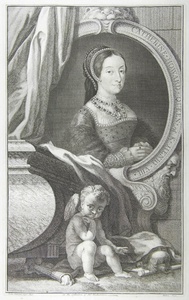| Method | Copper engraving |
| Artist | Jacobus Houbraken after Hans Holbein the Younger |
| Published | [c.1739] |
| Dimensions | Image 354 x 217 mm, Plate 363 x 227 mm, Sheet 493 x 335 mm |
| Notes |
Portrait of Catherine Howard, set within an ornamental oval, turned slightly to the right, and with her hands clasped. She wears a dress and a French hood, both adorned with jewels, and a fur cloak around her arms. Upon the floor, partially covered by a falling curtain, is Catherine's decapitated head, shown next to an axe. A putto sits beside the head, with a partially extinguished torch. This portrait of Catherine Howard is an early impression from a series of portraits that illustrated British royalty and nobility. The portraits featured in the series, which were engraved by Jacob Houbraken and George Vertue, were originally issued from 1737 onwards in portfolios of four portraits. Between 1743 and 1752, the series was published by John and Paul Knapton in London in the form of Birch's The Heads of Illustrious Persons of Great Britain, and contained biographies alongside the portraits. The number of plates included varied from edition to edition. Although the majority contained 108 plates, some editions contained as many as 120. Houbraken was responsible for producing a large proportion of the portraits, with Vertue only engraving around seven. The ornamental surroundings featured on the plates were engraved prior to the portraits, and were done so by Hubert-François Gravelot. Catherine Howard (c.1523 - 1542) was the fifth wife of Henry VIII, and reigned as Queen of England between 1540 and 1541. Henry VIII had married Catherine only days after the annulment of his marriage to Anne of Cleves. After a short marriage to the king, Catherine was beheaded on the grounds of treason, and for committing adultery. Jacob, or Jacobus, Houbraken (1698-1780) was a Dutch portrait engraver, and dealer and collector of Rembrandt's etchings. Born in Dordrecht, he was the son of the artist Arnold Houbraken. In 1707 he moved to Amsterdam, where he assisted his father on a book of the lives of the Dutch Golden Age artists, entitled De Groote Schouburgh der Nederlantsche konstschilders en schilderessen (1718-1721). Between 1743 and 1752, Houbraken worked with George Vertue on Thomas Birch's Heads of Illustrious Persons of Great Britain. He also engraved the portraits for Jan van Gool's Nieuwe schouburg der Nederlantsche kunstschilders (1750-51). Between 1752 and 1759, he worked on Jan Wagenaar's Vaderlandsche historie, which was published by Isaac Tirion. Hans Holbein the Younger (1497 - 1543) was a painter, draughtsman and designer of woodcuts. He also worked with glass-paintings, metalwork, and jewellery. Holbein was born in Augsburg. He worked in Basel as a journeyman at the end of 1515, and was first employed there with Ambrosius by humanist scholars and their printers. In 1519, he was admitted to the painters' guild. With an introduction from Erasmus to Sir Thomas More he left for England at the end of August 1526 and stayed for two years working in the court circle before returning to Basel. He returned to England in 1532 and, under the patronage of Henry VIII, he produced a succession of magnificent portraits. The most famous of which was the mural painting glorifying the Tudor dynasty in the Whitehall Palace. It was regrettably destroyed in the fire of 1698. O'Donoghue 2, Ver Huell 3 Condition: Light discolouration to margisn. |
| Framing | unmounted |
| Price | £90.00 |
| Stock ID | 40108 |

